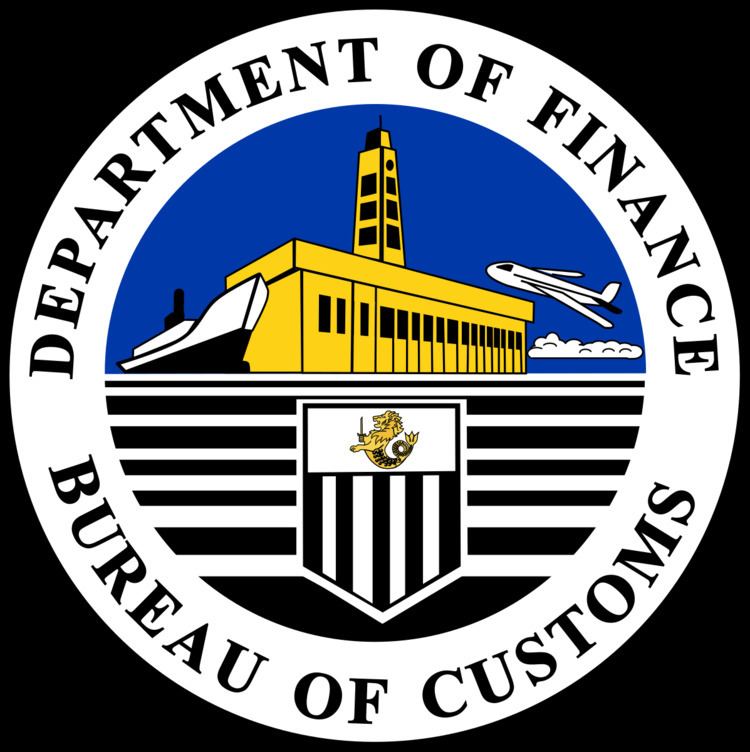Formed February 5, 1902 | Abbreviation BoC, BOC National agency Philippines | |
 | ||
Legal personality Governmental: Government agency General nature Law enforcementCivilian agency | ||
The Bureau of Customs (abbreviated BoC or BOC; Filipino: Kawanihan ng Adwana) is a Philippine government agency under the Department of Finance. It is responsible for regulating and facilitating trade, assessment and collecting import duties and taxes, combating illegal trade and other forms of customs fraud, and devising and managing customs management systems for trade facilitation.
Contents
- History
- The Spanish Regime
- The American Regime
- The Commonwealth Government
- The Republic
- Office of the Commissioner OCOM
- Collection Districts
- References
The Bureau of Customs was established on February 5, 1902 by the Insular Government, while the Philippines was a possession of the United States.
History
Historical records show that the customs service in the Philippines started many centuries back long before it was discovered by the eastern and western expeditionaries. The Philippines had already a flourishing trade with countries of Southeast Asia, but since money at that time was not yet the medium of exchange, people then resorted to the barter system of commodities. The rulers of the barangays were known as the datu or rajahs collected tributes from the people before they were allowed to engage in their trade. The practice of collecting tributes became part of their culture and was then observed and followed as the Customs Law of the Land.
The Spanish Regime
After Spain had taken full control of almost all the trades of the country, it passed three important statutes:
The American Regime
When the Americans came to the Philippines, the Military Government continued to enforce the Spanish Tariff Code of 1891, which remained in effect until the Philippine Commission enacted the Tariff Revision Law of 1901.
On October 24, 1900, the Philippine Commission passed Act No. 33 abolishing and changing the position of Captain of the Port to Collector of Customs in all ports of entry except the Port of Manila. The designation of the Captain of the Port in the Port of Manila was retained.
When the Civil Government was established in the Philippines, the most important laws passed by the Philippine Commission were the following:
When the Department of Justice became a separate office from the Department of Finance, the customs service remained under the umbrella of the latter which set-up remained up to this time.
The Commonwealth Government
After the Commonwealth Government was established in the country, the Philippine Legislature enacted Commonwealth Act No. 613 forming the Bureau of Immigration as a separate office from the Bureau of Customs.
On May 1, 1947, the Bureau of Customs has as its head the Insular Collector of Customs. He was assisted by the Deputy Insular Collector of Customs. Both officials were concurrently Collector of Customs and the Deputy Collector of Customs of the Port of Manila. The Republic Pursuant to the Executive Order No. 94 of Republic Act No. 52, the President of the Philippines reorganized the different departments, bureaus, offices and agencies of the government of the Republic of the Philippines. Consequently, the Insular Collector of Customs was changed to Collector of Customs for the Port of Manila. The reorganization took effect on July 1, 1947.
In 1957, Congress enacted the Tariff and Customs Code of the Philippines known as Republic Act No. 1937, otherwise known as the “Tariff Law of the Republic of the Philippines”. This took effect on July 1, 1957. The passage of this act by the defunct Congress of the Philippines subject to the provisions of the Laurel-Langley Agreement, became the first official expression of an autonomous Philippine Tariff Policy.
Before the passage of Republic Act 1937, all importations from the United States enjoyed full exemptions pursuant to the Tariff Act No. 1902 which was adopted by Republic Act No. 3 as the Tariff Laws of the Philippines.
The Republic
Pursuant to the Executive Order No. 94 of Republic Act No. 52, the President of the Philippines reorganized the different departments, bureaus, offices and agencies of the government of the Republic of the Philippines. Consequently, the Insular Collector of Customs was changed to Collector of Customs for the Port of Manila. The reorganization took effect on July 1, 1947.
In 1957, Congress enacted the Tariff and Customs Code of the Philippines known as Republic Act No. 1937, otherwise known as the “Tariff Law of the Republic of the Philippines”. This took effect on July 1, 1957. The passage of this act by the defunct Congress of the Philippines subject to the provisions of the Laurel-Langley Agreement, became the first official expression of an autonomous Philippine Tariff Policy.
Before the passage of Republic Act 1937, all importations from the United States enjoyed full exemptions pursuant to the Tariff Act No. 1902 which was adopted by Republic Act No. 3 as the Tariff Laws of the Philippines.
Office of the Commissioner (OCOM)
The Bureau of Customs is headed by a Commissioner, who is responsible for the general administration and management of the bureau. The Commissioner is assisted by six (6) Deputy Commissioners, who supervises the Internal Administration Group, Revenue Collection Monitoring Group, Assessment and Operations Coordination Group, Intelligence Group, Enforcement Group, and Management Information System and Technology Group.
Collection Districts
The Commissioner is also assisted by seventeen (17) District Collectors who supervises the seventeen Collection Districts and responsible for the implementation of customs laws, and policies and programs of the bureau in different ports of entry in the country.
